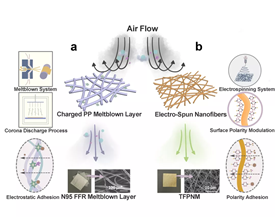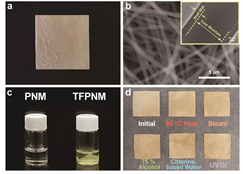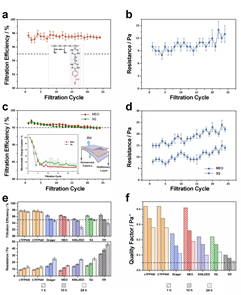Qifei Wang,Yingzhen Wei,Wenbo Li,Xizi Luo,Xinyue Zhang,Dr. Jiancheng Di,Prof. Guoqing Wang,Prof. Jihong Yu
Q. Wang, Y. Wei, W. Li, Dr. J. Di, Prof. J. YuState Key Laboratory of Inorganic Synthesis and Preparative Chemistry, College of Chemistry, Jilin University Changchun 130012 (P. R. China)E-mail: jihong@jlu.edu.cn
Prof. J. Yu International Center of Future Science, Jilin University Changchun 130012 (P. R. China)
X. Luo, X. Zhang, Prof. G. Wang Department of Pathogenbiology, Chinese Ministry of Education, College of Basic Medicine, Jilin University Changchun, 130021 (P. R. China)
The worldwide COVID-19 pandemic has led to an extensive attention on the usage of N95-grade face respirators(N95 FFRs), which are dominated by external electrostatic charged polypropylene meltblown fabrics. However, their longevity and reusability are limited by consecutive donning and disinfection treatments. Herein, we developed stable N97 nanofibrous respirators based on chemically modified surface to enable remarkable filtration characteristics via polarity driven interaction. This was achieved by a thin-film coated polyacrylonitrile nanofibrous membrane (TFPNM), giving an overall long-lasting filtration performance with high quality factor at 0.42 Pa -1 (filtration efficiency: over 97%; pressure drop: around 10 Pa), which is higher than that of the commercial N95 FFRs (0.10-0.41 Pa -1 ) tested with a flow rate of 5 L/min and the 0.26 μm NaCl aerosol. A coxsackie B4 virus filtration test demonstrated that TFPNM also had strong virus capture capacity of 97.67%. As compared with N95 FFRs, the TFPNM was more resistant to a wider variety of disinfection protocols, and the overall filtration characteristics remained N97 standard.

Figure 1. Illustration of overall characteristics and particulates capture mechanism of N95 FFR and TFPNM.

Figure 2. The morphology and stability of TFPNMS.

Figure 3. Filtration characteristics of TFPNMs and the filtering layers of multiple brands N95 FFRs.
Related link:https://doi.org/10.1002/anie.202108951